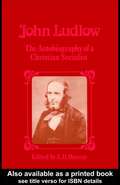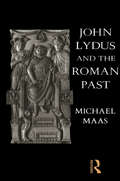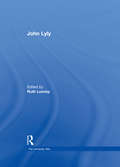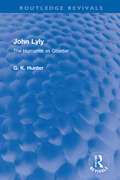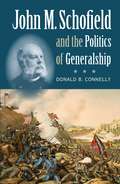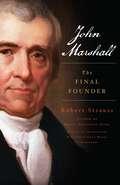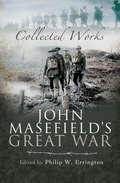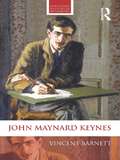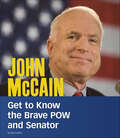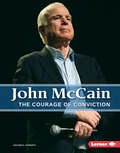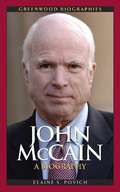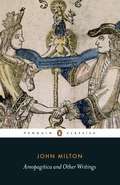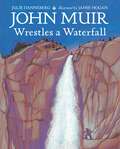- Table View
- List View
John Ludlow: The Autobiography of a Christian Socialist
by A. D. MurrayFirst published in 1981, 'John Ludlow; A Christian Socialist' is an important contribution to the field of History.
John Lydus and the Roman Past: Antiquarianism and Politics in the Age of Justinian
by Michael MaasJohn Lydus and the Roman Past offers a new interpretation of the emergence of Byzantine society as viewed through the eyes of John Lydus, a sixth-century scholar and civil servant. Maas show that control of classical inheritance was politically contested in the reign of Justinian. He demonstrates how the past could be used to convey legitimacy and social definition at a time of profound change.
John Lyly (The University Wits)
by Ruth LunneyJohn Lyly is the first collection of essays dedicated solely to the work of this University Wit, celebrity prose writer, and playwright to the court of Elizabeth. Lyly's energy and wit inspired his contemporaries to follow new directions in prose fiction and stage comedy, and his writings still illuminate sixteenth-century culture for the modern reader. The twenty-four essays in this selection include some older classics, but most date from 1990 onwards and reflect current critical concerns with politics and sexuality, class and audience. Both Euphues books and the eight plays receive some detailed attention. The essays are grouped into four sections: Lessons in Wit, Courting the Queen, Playing with Desire, and Performing Lyly. A biographical summary and critical survey are provided in the introduction; other voices and insights are alluded to in the notes and listed in the wide-ranging bibliography.
John Lyly: The Humanist as Courtier (Routledge Revivals)
by G K HunterFirst published in 1962, John Lyly marks a shift from the traditional focus on John Lyly as the originator of the strange stylistic craze called Euphuism, and as the dramatist from whose plays Shakespeare deigned to borrow some of his earliest and least attractive comic devices to an author whose works are excellent in themselves. Critics have suggested that an independent reading of Euphues, and more especially of the plays, reveals an attractive delicacy of wit and a refined power of linguistic filigree quite independent of his influence on others or his capacity to illustrate the curious tastes of our forefathers. The eight plays – his most mature artistic achievements – are analysed in detail to bring out their relation to the tradition of court drama. A final chapter compares Lyly and Shakespeare in an attempt to show in operation the different traditions which the book has discussed. This book will appeal to students of English literature, drama and literary history.
John M. Schofield and the Politics of Generalship
by Donald B. ConnellyIn the first full biography of Lieutenant General John McAllister Schofield (1831-1906), Donald B. Connelly examines the career of one of the leading commanders in the western theater during the Civil War. In doing so, Connelly illuminates the role of politics in the formulation of military policy, during both war and peace, in the latter half of the nineteenth century.Connelly relates how Schofield, as a department commander during the war, had to cope with contending political factions that sought to shape military and civil policies. Following the war, Schofield occupied every senior position in the army--including secretary of war and commanding general of the army--and became a leading champion of army reform and professionalism. He was the first senior officer to recognize that professionalism would come not from the separation of politics and the military but from the army's accommodation of politics and the often contentious American constitutional system. Seen through the lens of Schofield's extensive military career, the history of American civil-military relations has seldom involved conflict between the military and civil authority, Connelly argues. The central question has never been whether to have civilian control but rather which civilians have a say in the formulation and execution of policy.
John Macnab
by John Buchan Andrew GreigIn 1925, John Buchan published his second most famous novel, "John MacNab"; three high-flying men -- a barrister, a cabinet minister and a banker -- are suffering from boredom. They concoct a plan to cure it. They inform three Scottish estates that they will poach from each two stags and a salmon in a given time. They sign collectively as 'John McNab' and await the responses. This novel is a light interlude within the "Leithen Stories" series - an evocative look at the hunting, shooting and fishing lifestyle in Highland Scotland.
John Marshall and the Heroic Age of the Supreme Court (Southern Biography Series)
by R. Kent NewmyerJohn Marshall (1755--1835) was arguably the most important judicial figure in American history. As the fourth chief justice of the United States Supreme Court, serving from 1801 to1835, he helped move the Court from the fringes of power to the epicenter of constitutional government. His great opinions in cases like Marbury v. Madison and McCulloch v. Maryland are still part of the working discourse of constitutional law in America. Drawing on a new and definitive edition of Marshall's papers, R. Kent Newmyer combines engaging narrative with new historiographical insights in a fresh interpretation of John Marshall's life in the law. More than the summation of Marshall's legal and institutional accomplishments, Newmyer's impressive study captures the nuanced texture of the justice's reasoning, the complexity of his mature jurisprudence, and the affinities and tensions between his system of law and the transformative age in which he lived. It substantiates Oliver Wendell Holmes Jr.'s view of Marshall as the most representative figure in American law.
John Marshall: The Final Founder
by Robert StraussEighteenth- and 19th-century contemporaries believed Marshall to be, if not the equal of George Washington and Benjamin Franklin, at least very close to that pantheon. John Marshall: The Final Founder demonstrates that not only can Marshall be considered one of those Founding Fathers, but that what he did as the Chief Justice was not just significant, but the glue that held the union together after the original founding days. The Supreme Court met in the basement of the new Capitol building in Washington when Marshall took over, which is just about what the executive and legislative branches thought of the judiciary. John Marshall: The Final Founder advocates a change in the view of when the &“founding&” of the United States ended. That has long been thought of in one or the other of the signing of the Constitution, the acceptance of the Bill of Rights or the beginning of the Washington presidency. The Final Founder pushes that forward to the peaceful change of power from Federalist to Democrat-Republican and, especially, Marshall&’s singular achievement -- to move the Court from the basement and truly make it Supreme.
John Marshall: The Man Who Made the Supreme Court
by Richard BrookhiserThe life of John Marshall, Founding Father and America's premier chief justice In 1801, a genial and brilliant Revolutionary War veteran and politician became the fourth chief justice of the United States. He would hold the post for 34 years (still a record), expounding the Constitution he loved. Before he joined the Supreme Court, it was the weakling of the federal government, lacking in dignity and clout. After he died, it could never be ignored again. Through three decades of dramatic cases involving businessmen, scoundrels, Native Americans, and slaves, Marshall defended the federal government against unruly states, established the Supreme Court's right to rebuke Congress or the president, and unleashed the power of American commerce. For better and for worse, he made the Supreme Court a pillar of American life. In John Marshall, award-winning biographer Richard Brookhiser vividly chronicles America's greatest judge and the world he made.
John Masefield's Great War: Collected Works
by John MasefieldJohn Masefield wrote four books on The Great War: Gallipoli, The Old Front Line, War and the Future and Battle of the Somme. These have been acclaimed as perceptive and beautiful crafted works, which bring home the full horror and hopelessness of war. This is the first opportunity for historians and general readers to purchase all four in a handsome yet reasonably priced volume, which is definitely a collectable. In addition there is a full introduction by Dr. Philip Errington, the leading Masefield authority who is head of Sotheby's Department of Printed Books and Manuscripts. This rare collection is rounded off by a selection of shorter pieces by the hugely popular Poet Laureate.
John Maynard Keynes (Routledge Historical Biographies)
by Vincent BarnettJohn Maynard Keynes is arguably the most important and influential economist of the twentieth century, and stands alongside Adam Smith and Karl Marx as one of the most famous economic thinkers of all time. Keynes’s radical reassessment of the accepted principles of economics led to new ways of thinking about how to deal with financial crises and economic depressions, and encouraged governments to increase levels of state investment to create economic growth. This historical biography shows how Keynes was more than an academic theorist and how his policy proposals had a significant impact on the economic and financial architecture of many Western countries from the 1920s onward, and on the post-war international financial system. It also tells the story of his colourful private life - Keynes was an active member of the Bloomsbury group of artists and intellectuals, he entertained various ‘secret’ male lovers in his youth, he married a famous Russian ballerina in 1925 and he was also an astute collector of fine art and antiquarian books. Vincent Barnett emphasizes the relationship between the personal and professional by presenting the book chapters in pairs, examining first the central features of Keynes’s life, personal development and policy ideas over the period in question, and then the theoretical content of his major writings from the same period. Barnett argues controversially that allowing psychology a much greater role within economics was a main but often-neglected feature of The General Theory of Employment, Interest and Money, and that Keynes’s policy writings were more concerned with the Britain’s national interest than is sometimes recognised. The result is a concise new biography that is both intellectually rigorous and easily accessible to students and anyone else seeking to understand the life and work of England‘s foremost economist.
John McAndrew's Modernist Vision: #N/A
by Mardges BaconJohn McAndrew's Modernist Vision tells the compelling story of the architect, scholar, and curator John McAndrew, who played a key role in redefining modernism in the United States from the 1930s onward. The designer of the Vassar College Art Library—arguably the first modern interior on a college campus—and the curator of architecture at the Museum of Modern Art in New York from 1937 to 1941, McAndrew was instrumental in creating a distinct and innovative aesthetic that bridged the European modernist lineage and American regional vernacular. Providing a fascinating glimpse into McAndrew's life, his associations with important architects and artists, and the historical context that shaped his work, this book is a thoroughly researched testament to a man who left a powerful mark on the evolution of American architecture.
John McCain: A Little Golden Book Biography (Little Golden Book)
by Gram AdamsHelp your little one dream big with a Little Golden Book biography that's all about Senator John McCain! It's the perfect introduction to nonfiction for preschoolers.This Little Golden Book about John McCain--the Vietnam war veteran, six-term U.S. senator from the state of Arizona, and Republican presidential nominee—is an inspiring read-aloud for young girls and boys.Look for more Little Golden Book biographies: • Misty Copeland • Frida Kahlo • Iris Apfel • Bob Ross • Queen Elizabeth II • Harriet Tubman
John McCain: An American Hero
by Beatrice GormleyLearn all about the life of Senator John McCain in this enlightening biography specially written for a younger audience. Five-term Arizona senator John S. McCain’s indelible mark on America was perhaps his destiny, as his grandfather proclaimed when he was just an infant, “This boy has the stamp of nobility on his brow.” <P><P> Following both his four-star US Navy father and grandfather into military service, McCain’s naval career imprinted the code of honor he has maintained to this day. Throughout the myriad life and death perils he faced—most notably being held captive as a Vietnam War prisoner of war for five and one half years in the Hoa Lo Prison or ‘Hanoi Hilton’—his courage, bravery, and tenacity has served him time and time again: as Navy liaison to the US Senate, as a member (and then chairman) on the Armed Services Committee, Commerce Committee, and Indian Affairs Committee, playing a key role in restoring diplomatic relations with Vietnam, championing finance reform by sponsoring the McCain-Feingold Act, and as the Republican nominee for president in 2008. <P><P> Beatrice Gormley’s enriching biography tells the riveting story of one of America’s last, great, enduring heroes.
John McCain: Get to Know the Brave POW and Senator (People You Should Know)
by Dani GabrielBefore he was a senator, John McCain fought in the Vietnam War and served in the House of Representatives. He ran for president of the United States in 2008. Get to know the maverick who was willing to speak his mind.
John McCain: The Courage of Conviction (Gateway Biographies Ser.)
by Heather E SchwartzThis timely title examines the remarkable life and death of John McCain, from his time as a decorated war veteran to elder statesman. Accessible text and plentiful photos cover McCain's early life, his military career, his political legacy, and his 2017 diagnosis of brain cancer. Up-to-the-minute details round out this latest look at a uniquely American figure.
John Mccain: A Biography
by Elaine S. PovichJohn McCain's "maverick" streak and military-forged code of honor have coexisted uneasily at times with the demands of his political career and his determined pursuit of the presidency.
John Mcgraw
by Charles AlexanderSpanning forty years from the 1890s to the post-World War I decade is this life story of one of baseball's most charismatic, competitive, and savvy players--and the most accomplished manager the game has ever known. 8-page photo insert.
John Milton: Areopagitica and Other Writings
by John Milton William PooleJohn Milton was celebrated and denounced in his own time both as a poet and as a polemicist. Today he is remembered first and foremost for his poetry, but his great epic Paradise Lost was published very late in his life, in 1667, and in his own time most readers more readily recognized Milton as a writer of prose. This superbly annotated new book is an authoritative edition of Milton’s major prose works, including Of Education, The Tenure of Kings and Magistrates, and the Divorce tracts, as well as the famous 1644 polemical tract opposing licensing and censorship, Areopagitica. For more than sixty-five years, Penguin has been the leading publisher of classic literature in the English-speaking world. With more than 1,500 titles, Penguin Classics represents a global bookshelf of the best works throughout history and across genres and disciplines. Readers trust the series to provide authoritative texts enhanced by introductions and notes by distinguished scholars and contemporary authors, as well as up-to-date translations by award-winning translators.
John Muir Wrestles a Waterfall
by Julie DannebergThe now iconic figure John Muir, while living at the base of Yosemite Falls in California, ventures up the trail from his cabin one night and has a harrowing waterfall adventure. Back matter roots the story in Muir’s life’s work as a conservationist and naturalist.
John Muir and the Ice That Started a Fire: How a Visionary and the Glaciers of Alaska Changed America
by Kim HeacoxA dual biography of two of the most compelling elements in the narrative of wild America, John Muir and Alaska.John Muir was a fascinating man who was many things: inventor, scientist, revolutionary, druid (a modern day Celtic priest), husband, son, father and friend, and a shining son of the Scottish Enlightenment -- both in temperament and intellect. Kim Heacox, author of The Only Kayak, bring us a story that evolves as Muir’s life did, from one of outdoor adventure into one of ecological guardianship---Muir went from impassioned author to leading activist. The book is not just an engaging and dramatic profile of Muir, but an expose on glaciers, and their importance in the world today. Muir shows us how one person changed America, helped it embrace its wilderness, and in turn, gave us a better world.December 2014 will mark the 100th anniversary of Muir’s death. Muir died of a broken heart, some say, when Congress voted to approve the building of Hetch Hetchy Dam in Yosemite National Park. Perhaps in the greatest piece of environmental symbolism in the U.S. in a long time, on the California ballot this November is a measure to dismantle the Hetch Hetchy Dam.Muir’s legacy is that he reordered our priorities and contributed to a new scientific revolution that was picked up a generation later by Aldo Leopold and Rachel Carson, and is championed today by influential writers like E.O. Wilson and Jared Diamond. Heacox will take us into how Muir changed our world, advanced the science of glaciology and popularized geology. How he got people out there. How he gave America a new vision of Alaska, and of itself.
John Mulholland's Story of Magic: The Development of the Art of Illusion by the CIA's Master Magician
by John MulhollandMagic has entranced public forums for hundreds of years, predating many other forms of entertainment that we enjoy today. This ancient art, with its captivating illusions and seemingly impossible sleight of hand, is still as relevant today as ever. Originally published in 1935, master magician John Mulholland’s Story of Magic is a delightful tour through the progression of magic, from its origin to the book’s contemporary period. It offers insights and reflections on famous routines and tricks, black-and-white photographs and illustrations to give readers visual reference, as well as informative facts that weave together a timeline of events for those interested in the history of magic. With a brand-new foreword written by renowned master magician and historian Ben Robinson, this timeless classic will enchant readers and educate them on the art of magic.
